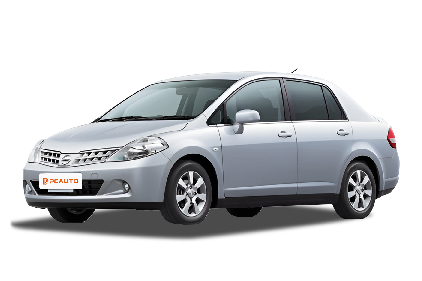Q
How much torque does a Nissan latio have?
The torque output of the Nissan Latio depends on the specific model and engine configuration. Take the commonly - seen 1.6 - liter HR16DE four - cylinder naturally aspirated engine in the Malaysian market as an example. Its maximum torque is approximately 153 Newton - meters (Nm), and the peak torque is usually reached at around 4000 rpm. It is paired with a 4 - speed automatic or 5 - speed manual transmission, which meets the needs of city driving. If it is the version with a 1.8 - liter MR18DE engine (such as the Latio Sport), the torque can be increased to 174 Newton - meters, offering more powerful performance.
Torque is a key indicator for measuring the rotational force of an engine. A higher torque value means stronger traction during acceleration or climbing. However, the actual driving experience needs to be comprehensively judged in combination with horsepower, vehicle weight, and gearbox tuning. In Malaysia's hilly and congested road conditions, the Latio's linear torque output can balance fuel economy and smoothness, making it practical enough for daily commuting.
It is recommended that car owners conduct regular maintenance to ensure the engine's efficiency. At the same time, choose the appropriate oil viscosity (such as 5W - 30) to maintain the best torque performance.
Special Disclaimer: This content is published by users and does not represent the views or position of PCauto.
Related Q&A
Q
What is another name for the Nissan latio?
In the Malaysian market, the Nissan Latio is also known as the Nissan Sylphy. This model is a compact sedan launched by Nissan for the Asian market, focusing on comfort and fuel economy. The Nissan Latio/Sylphy is quite popular in Malaysia. Its spacious interior and reliable performance make it a popular choice for family cars. This model is equipped with a 1.6L or 1.8L naturally aspirated engine, paired with a CVT transmission, providing a smooth driving experience. In addition, the Nissan Latio/Sylphy is also equipped with a number of practical features, such as a smart key system, automatic air - conditioning, and a rear - view camera, which further enhance driving convenience. For Malaysian consumers, the Nissan Latio/Sylphy is not only an affordable daily commuter but also meets the needs of long - distance travel. It is a highly cost - effective model.
Q
Where is Latio from?
The Latio is a compact sedan under Nissan. Initially designed and produced by the Japanese automaker Nissan Motor Company, it's mainly targeted at the Asian market, including Malaysia. This car was once popular in the Malaysian market for its affordability, high fuel efficiency, and strong reliability, making it suitable for city driving and family use.
The Malaysian version of the Latio is typically equipped with a 1.6L or 1.8L engine, offering a comfortable riding experience and a practical interior design. For Malaysian consumers, the Latio is a cost - effective choice, especially for daily commuting and family outings.
As a globally well - known automotive brand, Nissan has an extensive sales and service network in Malaysia, providing reliable after - sales support for car owners. Moreover, the used - car market performance of the Latio is relatively stable, with a high resale value, which further enhances its appeal in the Malaysian market.
If you're thinking about buying an economical and practical used car, the Latio is a worthy option. However, it's advisable to conduct a detailed inspection of the vehicle's condition before purchase and choose a dealer or seller with a good reputation.
Q
How much fuel does a Nissan latio use per 100km?
The fuel consumption of the Nissan Latio varies depending on the model and driving conditions. According to official data and user feedback, its combined fuel consumption is approximately 6 to 7 liters per 100 kilometers. The specific figure is affected by driving habits, road conditions, and vehicle maintenance. For instance, the fuel consumption may be slightly higher in congested urban areas, while it's more fuel - efficient during highway cruising.
For Malaysian consumers, as an economical and practical family sedan, the Latio has a relatively balanced fuel efficiency among vehicles in the same class, making it suitable for daily commuting and family use. To further reduce fuel consumption, it's recommended to have the vehicle regularly maintained, keep the tire pressure normal, and avoid bad driving habits such as sudden acceleration and hard braking.
Moreover, the fuel prices in Malaysia often fluctuate due to government subsidies. Choosing a fuel - efficient model can effectively reduce long - term vehicle usage costs, and the Latio's fuel consumption performance has certain advantages in this regard.
Q
Is Nissan Latio the same as Nissan Tiida?
The Nissan Latio and Nissan Tiida are actually the same model with different names in different markets. In the Malaysian market, Latio was the early name for Tiida. Later, as the model was updated, the name was gradually unified to Tiida. These two cars share the same platform and core technologies, including the engine, transmission, and chassis design. The main differences lie in the exterior details and configuration options. For example, the Latio may focus more on comfort features, while the Tiida leans towards a sportier design. For Malaysian consumers, whether it's the Latio or Tiida, they both inherit the consistent reliability and fuel efficiency of Nissan models, making them suitable for daily family use. It's worth mentioning that the Tiida is sold in multiple markets around the world, but the configuration and tuning will be adjusted according to local needs. For instance, the Malaysian version of the Tiida may place more emphasis on durability in tropical climates. If you're considering buying this car, it's recommended to test - drive the latest Tiida at a local Nissan dealership to experience its actual performance.
Q
How much horsepower does the Nissan Latio engine have?
The Nissan Latio available in the Malaysian market is equipped with a 1.6-liter HR16DE naturally aspirated engine. It boasts a maximum horsepower of around 110 PS and a torque of 153 Nm. This engine is well - known for its durability and fuel economy, making it a great fit for city driving.
As an economical family car, the Latio's power performance is more than enough to meet the daily commuting needs. Meanwhile, it maintains a relatively low fuel consumption level, which aligns with the Malaysian consumers' emphasis on practicality and cost - effectiveness. If you have higher power requirements, you may consider the turbocharged versions of other models in the same class. However, the Latio shines with its low maintenance cost and high reliability, which are the very reasons why many Malaysian families opt for it.
In terms of engine technology, the HR16DE adopts the Continuously Variable Valve Timing Control (CVTC) technology, which optimizes power output and fuel efficiency. This kind of technology is quite common in modern small cars and can strike a balance between performance and environmental protection needs.
Q
How many cc is a Nissan Latio?
In the Malaysian market, the Nissan Latio mainly offers two engine displacement options, namely 1.6 liters and 1.8 liters, with the corresponding specific cc figures being 1598cc and 1797cc. Both of these two engines feature a four - cylinder design, which is suitable for daily city driving and family use, boasting good fuel economy and reliability. As a popular compact sedan, the Nissan Latio has won the favor of many consumers in the Malaysian market with its comfortable riding experience and practical space design. For readers who want to learn more about automotive knowledge, cc (cubic centimeters) is an important indicator for measuring engine displacement. Generally, the larger the displacement, the stronger the power output, but the fuel consumption may also increase accordingly. Therefore, when choosing a vehicle, one needs to comprehensively consider personal needs and budget. The Nissan Latio has mature engine technology and relatively low maintenance costs. It is suitable for the road conditions and climate in Malaysia, making it a cost - effective choice for a family sedan.
Q
Is the Nissan Latio a fuel saver?
The Nissan Latio performs well in terms of fuel economy and is especially suitable for the urban driving environment in Malaysia. The 1.6L and 1.8L engines it is equipped with adopt Nissan's fuel - saving technologies, such as the CVT transmission and the intelligent fuel management system, which can effectively reduce fuel consumption. Official data shows that its combined fuel consumption is about 6 - 7L per 100km, which is a fuel - efficient option for daily commuting or family use.
In addition, Latio's lightweight body design and low drag coefficient also contribute to improving fuel efficiency. However, the actual fuel consumption will still be affected by driving habits, road conditions, and maintenance status. If you focus more on fuel - saving, you can consider regularly maintaining the tire pressure and avoiding sudden acceleration and hard braking. These habits can further optimize the fuel consumption performance.
Among vehicles in the same class, Latio's fuel economy is in the upper - middle level. Although it may not be as fuel - efficient as some hybrid models, it is still a good choice for users with limited budgets who need a reliable commuter car.
Q
What type of engine is in a Nissan Latio?
In the Malaysian market, the Nissan Latio is primarily equipped with a 1.6-liter HR16DE four-cylinder naturally aspirated engine. This engine features a double overhead camshaft (DOHC) design and a continuous variable valve timing control system (CVTC). These advanced technologies enable it to deliver a smooth power output and excellent fuel economy. With a maximum power of approximately 110 horsepower and a peak torque of around 153 Nm, the engine is well - suited for city driving and daily commuting.
The HR16DE engine has gained wide recognition in the Malaysian market for its reliability and low maintenance costs. It offers two transmission options: a 4 - speed automatic transmission or a 5 - speed manual transmission, catering to different driving preferences.
Digging a bit deeper, the technical features of the HR16DE engine are also evident in its lightweight design and low - friction internal components. These characteristics contribute to reduced fuel consumption and an extended engine lifespan. For Malaysian consumers, the stability of the engine in hot climates and its performance under air - conditioning loads are of particular importance. The engine of the Nissan Latio has been tuned to take into account the usage conditions in tropical regions, resulting in a well - balanced overall performance.
Q
Is Nissan Latio a CVT?
Yes, the Nissan Latio is indeed equipped with CVT (Continuously Variable Transmission) technology. Especially in models produced between 2004 and 2012, CVT was one of its main transmission options. This design aims to provide a smoother driving experience and better fuel economy, which is very suitable for the stop - and - go driving environment on Malaysian city roads.
Unlike traditional automatic transmissions, CVT achieves continuously variable speed through a steel belt and pulley system, avoiding the jerks during gear shifts. At the same time, it can more efficiently match the engine speed with the vehicle speed, reducing fuel consumption. For Malaysian consumers, when maintaining a CVT, it is necessary to pay attention to regularly replacing the special transmission fluid to ensure its long - term reliability.
Nissan's application of CVT technology in models like the Latio demonstrates the maturity of its powertrain. Similar technologies are also widely used in some models of other Japanese brands such as Toyota and Honda, making it one of the mainstream choices for economical family cars.
Q
Is Nissan Latio still in production?
Currently, the Nissan Latio has been discontinued. This model was initially launched in the Malaysian market in 2007. As an economical and practical four - door sedan, it was equipped with 1.6L and 1.8L engines. It was favored by many family users for its comfortable riding experience and fuel efficiency. However, with the change in market demand and product upgrading, Nissan gradually shifted its focus to other models such as the Almera and X - Trail, and the Latio finally left the production line.
For Malaysian consumers, although the Latio is no longer in production, you can still find well - maintained options in the used - car market. At the same time, the new models launched by Nissan locally also continue the brand's advantages in reliability and cost - effectiveness. If you're interested in models with a similar positioning, you can pay attention to the Nissan Almera. It features a more modern design and is equipped with a turbocharged engine, balancing power and fuel economy, which meets the current market demand.
Popular Cars
Model Year
Car Compare
Car Photo
Latest Q&A
Q
How reliable is a 2019 Porsche Macan?
The 2019 Porsche Macan delivers solid reliability, thanks to its proven 2.0T or 3.0T engines that offer consistent power delivery. The PDK dual-clutch transmission is another strong point—it’s both durable and buttery-smooth.
Porsche’s sporty DNA shines through in the Macan’s chassis tuning and all-wheel-drive system, yet it doesn’t compromise everyday comfort. Owner feedback suggests that sticking to the factory maintenance schedule keeps most examples running trouble-free, though be prepared for higher upkeep costs (as with any luxury vehicle).
Its strong resale value speaks volumes about its reputation for dependability. If you’re after driving thrills without sacrificing SUV practicality, the 2019 Macan is a compelling pick. Just be sure to get a pre-purchase inspection and verify full service history—it’ll pay off in the long run.
Q
How much is a 2019 Porsche worth?
The value of a 2019 Porsche depends on the model, mileage, condition, and specs. Take the popular Cayenne, for example—used ones typically go for between RM300k to RM500k. A 911 Carrera might range from RM500k to RM800k, while an entry-level 718 Boxster or Cayman could be around RM250k to RM400k. For luxury sedans like the Panamera, expect prices between RM350k to RM600k, but always check the actual condition and option list.
Porsches hold their value well, especially limited editions or high-performance GT models, but maintenance costs and service history play a big role in resale pricing. If you're buying, stick to official certified pre-owned channels or get a professional inspection. Always verify warranty transfers and repair records.
Pro tip: Compare listings on local used-car platforms and check recent sales data—market demand and inventory fluctuations affect pricing. Also, factory options (like sport packages or premium audio) can boost resale value, while accident history or multiple owners might slash the price by 10-20%.
Q
Does the 2019 Macan have a good sound system?
The 2019 Porsche Macan delivers an impressive audio performance, particularly with the optional Bose® Surround Sound System or the top-tier Burmester® High-End Surround Sound System—both offering an immersive listening experience.
The Bose® setup packs 14 speakers with 665 watts of total power, delivering crisp audio and punchy bass perfect for pop and electronic music. Meanwhile, the Burmester® system steps it up with 16 speakers and 1,000 watts, creating a wider soundstage and superior detail reproduction—ideal for classical or high-resolution tracks.
Both systems integrate seamlessly with Porsche’s standard Communication Management (PCM), supporting Apple CarPlay and multiple audio sources. If sound quality is a priority, be sure to specify your audio preference at purchase—the base model only comes with a standard speaker setup.
For the best performance, play lossless files via USB or high-quality Bluetooth codecs, and keep the system firmware updated for optimal operation.
Q
What is the resale value of a 2019 Macan?
The resale value of a 2019 Porsche Macan depends on factors like condition, mileage, specs, and service history. Current used prices hover between RM250k to RM350k, with higher trims commanding premium prices. As Porsche's entry SUV, the Macan holds its value better than most rivals thanks to brand prestige and sporty DNA – especially models optioned with Sport Chrono or full leather interiors fetching stronger money.
Pro tip: Get a pre-sale inspection and organize your maintenance paperwork – this really helps maximize resale. Macans move quickly in our local used market, with 3-5 year-old examples being the sweet spot when depreciation levels off. If you're upgrading, consider Porsche Approved Certified pre-owned – you'll pay a slight premium over private sales, but the extended warranty and factory refurbishment save headaches down the road.
Q
Is a 2019 Porsche Macan a good car?
The 2019 Porsche Macan is a well-rounded luxury SUV that stays true to Porsche's performance DNA while delivering everyday practicality. It comes with your choice of a peppy 2.0T or more powerful 3.0T engine, paired with Porsche's brilliant 7-speed PDK transmission that shifts like butter. The chassis strikes that sweet spot between sporty handling and comfortable cruising - perfect for both city commutes and weekend backroad blasts.
Inside, you'll find Porsche's typical top-notch craftsmanship with a standard 10.9-inch touchscreen featuring Apple CarPlay. Just don't expect limo-like rear legroom. These things hold their value surprisingly well, though maintenance will cost you more than your average SUV - but then again, you get Porsche's excellent service network.
Among its competitors, the Macan stands out for its driver engagement. If you want more grunt, step up to the Macan S or GTS. One pro tip: if you're shopping used, pay special attention to the PDK's condition and inspect the suspension components. Always better to go through Porsche's certified pre-owned program for that extended warranty peace of mind.
View MoreRelated News

It used to be as powerful as Hilux, but now it has to avoid competing with Hilux.
Kevin WongNov 18, 2025

In Malaysia, which sliding door MPVs are available?
MichaelOct 30, 2025

Nissan plans to open the Rogue hybrid platform to competitors like Ford to ease financial pressure
Kevin WongOct 11, 2025

2026 Nissan Leaf wins Wards Top 10 Powertrains Award
MichaelSep 25, 2025

Nissan officially releases the all-new 2026 Sentra, with updated exterior and interior
JamesSep 24, 2025
View More
















Pros
Cons